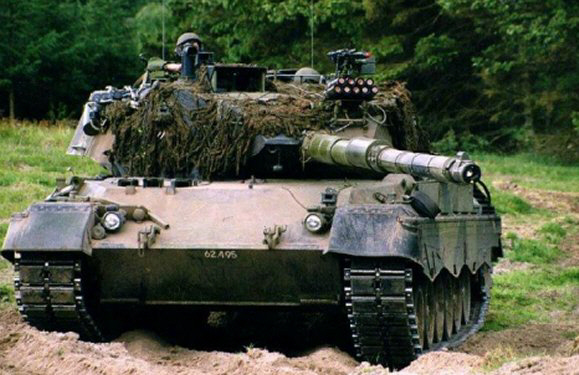How Tank Guns
Work
Home
Tank Guns
Tank armament started as
machine guns but this quickly changed to
cannons of varying sizes so that the tank
could deal with other armored targets and
fortified positions. Most of today's modern
tank guns are above 100mm, with 120mm being
the most common. These guns are equipped
with either a rifled or a smooth bore barrel
and are housed in a rotating turret that
allows the tank to engage targets at just
about any orientation. These guns are also
equipped with a bore evacuator that prevents
toxic gasses from the fired shell from
leaking into the crew compartment after the
shot has been fired.
Here you can see a tank with its turret
turned to the right. Also in about the
middle of the barrel you can see an object
that looks like a can, that is the bore
evacuator.

Image
source:http://battletanks.com/images/Leopard_1_Mod-1.jpg
The
Physics
When designing a tank gun, you
have to first decide if you are
going to use a rifled barrel or a
smooth bore barrel. The difference
being that the rifled barrel has
rifling grooves cut into the
barrel. The smooth bore barrel is
just that, a smooth barrel with no
rifling. The rifled barrel imparts
a spin on the projectile by use of
a series of grooves cut into the
barrel. This in turn makes the
projectile more accurate. A smooth
barrel does not have rifling, but
can shoot projectiles with more
force because there is less
friction on the projectile.
Pictured
below is a rifled 105mm
tank cannon. The rifling
in the picture is silver
because it has been chrome
plated. This is a common
way of preventing
corrosion in the bore.
Image
source:https://upload.wikimedia.org/wikipedia/commons/b/b2/105mm_tank_gun_Rifling.jpg
In the free body diagram below, I
have drawn two gun barrels with a
shot in them. The smooth bore will
have less friction if both guns
are the same size firing the same
projectile because its coefficient
of friction is less than that of
the rifled barrel and we know that
the force of friction is equal to
the coefficient of friction times
the normal force. This means that
a larger propellant
charge can be used on the shot
with less risk of damage to the
barrel or shot.
The bore
evacuator works by trapping high
pressure air from the shot as it
leaves the barrel and then
releasing the air into the low
pressure zone that the moving shot
creates, this then sucks out all
of the toxic gasses allowing the
crew to open the gun breech to
load another shot without inhaling
any harmful gas. Below I have
drawn a diagram to better explain.
|
|